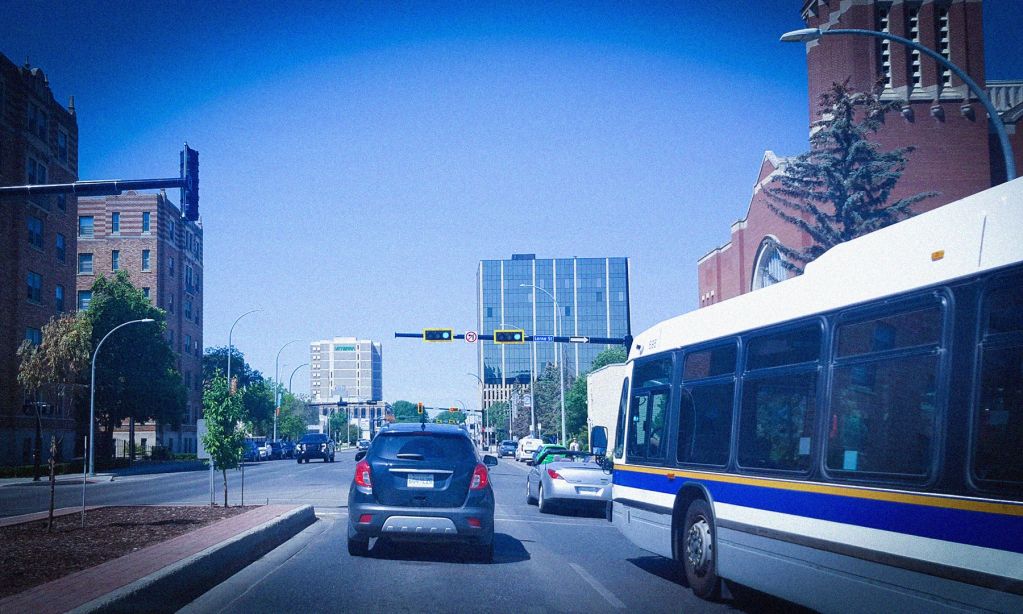If the supposed global “War on Cars” was true, then there is probably no city in North America where the automobile has won a more astounding and total victory than in Regina, Saskatchewan.
The hostility towards cyclists and pedestrians in the Queen City is the stuff of legend.
Beer cans launched from trucks at unsuspecting cyclists.
Catcalls and insults fired at pedestrians from speeding vehicles for having the temerity to walk the city’s streets.
Indeed, while the rest of the world seeks to make cities more pedestrian friendly, Regina is looking to eliminate its sole pedestrian-only street in the entire city.
While the rest of the world is eliminating parking minimums—the requirement for a certain amount of mandatory parking spaces tied to certain developments—a faction of city council in Regina tried to increase the number of parking spots tied to buildings.
This is in a city that has a downtown which already is home to half of the city’s parking lots.
Advocates of transportation modes other than the automobile often face an uphill battle in Regina.
While there have been encouraging improvements to cycling infrastructure, traffic calming measures and transit in the past few years, there is little doubt that city infrastructure is dominated by the automobile. Just as other cities are expanding bike lanes, introducing publicly funded bike share and e-scooter programs, and improving the experience for people who do the simple act of walking.
Some European cities—Paris, Barcelona—are actually restricting car usage in favour of pedestrian-friendly zones, parks, and patios. Copenhagen is renowned for its bike-friendly streets. Other cities in Canada are investing in public transit, to try to get people out of their cars and into more sustainable modes of transit.
None of this is landing in Regina. Our built environment is hostile to anyone who isn’t in an individually owned motorized vehicle.
The question is why? Why does Regina sometimes appear to be so hostile to non-motorized transportation that people feel compelled to yell out their car and truck windows at you?
Part of the explanation may be just sheer inertia. Regina—just like so many other cities in North America—has been designed around the needs of the automobile for more than 100 years.
As technology historian Peter Norton writes, the car-dependent city becomes “self-perpetuating,” as the demands of drivers, as a constituency, far outweighs the demands of bus riders or cyclists or pedestrians.
Financially strapped city governments are incentivized to deliver more infrastructure to cars than other modes of transportation that are less utilized.
But that doesn’t explain why Regina seems more hostile than other cities that are designed around the automobile.
Maybe it has to do with the very curious notion of freedom that is tied to fossil fuel use in Western Canada. Just as the automobile is embedded in our very material environment—through roads, traffic signs, parking garages, gas stations, etc.—so is it also deeply embedded in our culture and psyche. Perhaps nowhere more so than in Saskatchewan.
In a sparsely populated province the size of one-and-a-half Californias, Saskatchewan has the largest road network in the country.
With train travel a distant memory and our inter-city public bus company sold for spare parts, there is literally no other way to get around the province than by car.
The only way to liberate oneself from the yawning vastness of the prairies is to drive oneself.
If the day you earned your driver’s license felt liberating, it would be even more so in a place like Saskatchewan. And maybe the obverse is also true: those who are unwilling to ‘liberate’ themselves by driving the car are deserving of ridicule and contempt. Even though there is nothing more liberating than to use the two legs we were given to just get out there and go for a walk—studies correlate walking with good mental and physical health.
Political theorist Sudhir Chella Rajan argues that driving is so intertwined with supposed independence and the ability to participate in our society that “anyone incapable of owning and driving a car in present day North America has to be seen as lacking all the capacities and capabilities of citizenship.”
Maybe those insults and jeers leveled at those of us walking or biking are just meant to be motivations to embrace the freedom of automobility?
But as others have observed, if the automobile gives us freedom, it is a profoundly individual and privatized freedom.
While the car gives us, as individual drivers, substantial flexibility, privacy and control, it is often bought at the expense of the collective.
Accidents, sprawl, congestion—and, of course, rising carbon emissions—are the price we all pay for prioritizing the automobile.
It is, as political theorist John Meyer describes, a “classic conflict between private desires and public goods.”
But if there are only a paucity of public goods on offer, such as underfunded and irregular public transit, non-contiguous and unprotected bike lanes, or lack of sidewalks or traffic calming measures for pedestrians, then most will be forced to opt for the privatized version of freedom rather than no freedom at all.
And maybe it is within this context that we can better understand the mind of the pedestrian or cycling-hostile driver.
Left with only this privatized form of “freedom”—which has the peculiar quality of also sometimes being coercive (stuck in traffic, cost of maintaining a vehicle, no other travel options, chauffeuring children and the elderly)—any further constraint can be quite quickly viewed as an affront to that freedom.
Any curtailment of automobility, whether through increased gasoline or carbon taxes, reduced road space, protected lanes for transit, congestion pricing, or even “sharing the road” with others is viewed as a loss of freedom by drivers.
In effect, the roads have become a zero-sum game between drivers and everyone else: any win for pedestrians or cyclists or transit users is viewed as a loss for drivers.
Until we in North America have public goods that can rival the private freedoms of automobility, we will probably have to live with certain drivers believing that they are under siege and acting accordingly, consequences be damned.
But if public transportation options can deliver the reliability, comfort and convenience that are delivered daily in other countries, perhaps drivers will welcome their liberation from the automobile and all it entails.







